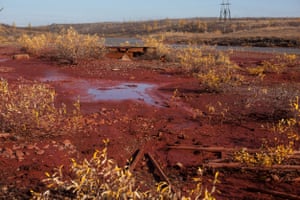A week before Russia’s Daldykan river was turned red by a leak from a metals plant, the UN issued a warning as chilling as it was overlooked: 323 million people are at risk from life-threatening diseases caused by the pollution of rivers and lakes.
Cholera, typhoid and other deadly pathogens are increasing in more than half of the rivers in Africa, Asia and Latin America, according to a UN environment programme (Unep) report. Salinity levels have also risen in nearly a third of waterways.
Asia has been worst hit, with up to 50% of all rivers now affected by severe pathogen pollution caused by a cocktail of untreated waste water disposal, agricultural pesticides run-off and industrial pollution.
In a telling footnote to the Russian Norilsk disaster, Nasa released satellite images on 15 September showing that far from being a one-off, the Daldykan river had turned red on multiple occasions in the past 20 years.

“There is often no incentive for companies and players high up in a river basin not to pollute,” says Paul Reig, an associate for the World Resources Institute. “The impacts are often not noticed until they are carried to water users downstream, especially when there are no regulatory requirements and no implementation or monitoring of water quality downstream to track it back.”
Global water demand from the manufacturing industry is projected to increase 400% by 2050, adding to pressure on river networks.
Reig argues that increased regulatory action is vital to tackle the 80% of waste water worldwide that is returned to rivers untreated. Incentives to recycle waste water are also needed to stimulate market demand for clean water technologies, he says.
But farming and raw sewage discharges also share responsibility for the 2m tonnes of untreated waste water that gushes into the world’s water supplies daily.
While industry, particularly in the developed world, is constrained by laws such as the EU’s water framework waste directive, pesticides and fertilisers can easily slide into water bodies unnoticed.
“The regulation of pollutants in agriculture is much less stringent, compared to industry and municipal waste water,” says Dietrich Borchardt, the lead author of the latest Unep report.
Borchardt points to the clean up of the river Rhine, which was one of the most heavily polluted rivers in the world, as well as effective waste water strategies by companies such as BASF and Bayer as examples of what can be done.
Regulation is pushing businesses across sectors to reduce their water footprint and environmental impact. The Japanese car company Toyota produces cars in China to a higher environmental standard than at home, he argues. And “no mining company is killing thousands of people in accidents. They would lose their licence and existence if they did. It is in their very basic interest not to,” Borchardt says.
There is also a strong public interest involved. An estimated 3.4 million people die each year from diseases associated with water-borne pathogens, nearly half of them children under five.
In the scheme of things, that awful statistic belies another: around 1.2 billion of the world’s people face water scarcity.
With water sources dwindling – Unesco predicts a 40% shortfall in supplies by 2030 – the global population spiralling towards 9 billion and water demand projected to increase exponentially, water management is becoming a vital issue for the 21st century.
Novel nature-based solutions that are cheaper and more effective than hi-tech approaches are gaining interest.
“These can involve leaving rivers intact from channelling, construction work or irrigation that disturbs their natural attenuation capacities,” Borchardt said. “A natural environment can degrade pollutants. Other solutions, especially in agriculture, can involve the preservation and construction of wetlands which are particularly efficient at removing nutrients from water.”
Paludiculture – which can be as simple as as planting water reeds to absorb excess nutrients from water bodies – is a win-win for environmentalists, maintaining a robust carbon sink and threatened peatlands in countries such as Malaysia and Indonesia.
Tackling waste water discharges at source is seen as a crucial first step, to avoid the devastating environmental damage that spillages can cause and the sky-rocketing costs of clean-up operations.
Reig said the “best interventions” to prevent water contamination were legal tools: “The drivers of untreated waste water discharges are poor governance of resources and water quality standards that are often non-existent (in the developing world) and not enforced, if they are there.”
Unep, though, puts greater emphasis on increased monitoring of water balances – knowing how much water there is, where is comes from and where pollutants travel from and to – to counter the scarcity of basic information about the inputs and outputs for waste water discharges into vulnerable water resources.
Borchardt said industry should be seen as a potential ally in the prevention of river pollution. “Business is a part of the solution and must be, because their products will find it more and more difficult to be sold on a huge global scale when there is a huge environmental bill attached,” he said.
River pollution puts 323m at risk from life-threatening diseases, says UN
Hiç yorum yok:
Yorum Gönder